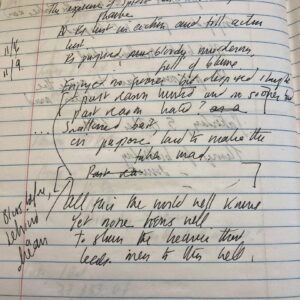Close-reading any poem by Wallace Stevens can look like hard, dizzying work, but it can become a happy romp rather than a baffled slog if you can do it with a friend who loves language as much as you do.
I know this because I have such a friend, one whom I recently invited to Zoom with me through Stevens’s “Note on Moonlight.” I chose this poem partly because it’s not one of Stevens’s heralded poems—so fellow rompers would be few. And also because it’s found in Stevens’s final volume, The Rock, which features poems written in old age. The exuberances of youth have quieted, but have not been silenced, and are all the more striking for the surprises they arouse. This geezer still has the old spark in him! And as readers getting on in years, we appreciated this display of energy. The poem is dizzying, for sure, but not an endurance test. Far from it!
Here’s the whole poem, which my friend and I spent almost an hour playing with and trading ideas about. An hour was not enough. Many hours would not have been.
Note on Moonlight The one moonlight, in the simple-colored night, Like a plain poet revolving in his mind The sameness of his various universe, Shines on the mere objectiveness of things. It is as if being was to be observed, As if, among the possible purposes Of what ones sees, the purpose that comes first, The surface, is the purpose to be seen, The property of the moon, what it evokes. It is to disclose the essential presence, say, Of a mountain, expanded and elevated almost Into a sense, an object the less; or else To disclose in the figure waiting on the road An object the more, an undetermined form Between the slouchings of a gunman and a lover, A gesture in the dark, a fear one feels In the great vistas of night air, that takes this form, In the arbors that are as if of Saturn-star. So, then, this warm, wide, weatherless quietude Is active with a power, an inherent life, In spite of the mere objectiveness of things, Like a cloud-cap in the corner of a looking-glass, A change of color in the plain poet’s mind, Night and silence disturbed by an interior sound, The one moonlight, the various universe, intended So much just to be seen— a purpose, empty Perhaps, absurd perhaps, but at least a purpose, Certain and ever more fresh. Ah! Certain, for sure…
Our first discovery about this poem is that it begins on—and really never leaves—the very solid ground of a lecture hall. The speaker, pointer in hand, blackboard behind him, opens with a dry categorical statement of apparent fact (“The one moonlight… etc.”) The poem itself looks, like all Stevens’s poems, very orderly. The metric scheme is rigid. We note a series of seven stanzas, each composed of four unrhymed quatrains, all following a secure though flexible iambic pentameter pattern. From the look of it, the poem is contained, submissive, obedient to the rules. The students, finishing their note, begin to nod off.
They shouldn’t, though even the title, “Note on Moonlight,” invites them to. In most of Stevens’s work, the orderly look of a poem is usually belied by the poem’s playful and ambiguous title. But “Note on Moonlight,” by comparison with Stevens’s usual titles, sounds rather staid. “Note on …” seems to promise that the poet wants only to take a bit of information about moonlight, jotting the info down for future reference, and in the process resolutely keeping his distance from whatever he notices. As if moonlight were just a thing in the sky like the moon itself rather than a kind of atmosphere, usually a romantic one.
Yet that oddly dry title is a tease. It tempts us readers to tweak that innocent little preposition “on” into what it should be,“ of”: into “Note of Moonlight.” Now the romantic vista suggested by “moonlight” begins to satisfy and expand. Some students (the alert ones) hear a Beethoven sonata in the background, as “note” becomes a musical mark on a staff, even a melodic moment.
Still, the dryness is maintained a little longer. Whatever the strain the poet feels about acknowledging the ambiguity of “moonlight” (whether a big chunk of stuff in the sky or a feeling), he bravely honors the preposition “on” of the title by laying out in his first stanza not only what, in the “on” case, the moonlight would consist of: that it would be “one,” denotatively singular—but also that it would do just one thing: “shine on the mere objectiveness of things.”
The challenge for the dozing students is that that little word “mere” assumes a comparison to far more fulfilling possibilities than staring at “mere objectiveness” and taking a note on it. Anyone taking such a note, or taking a note about that note, the poet suggests, is like a “…plain poet revolving in his mind / The sameness of his various universe….” But what a nightmarish bore a poet like this must be! Around and around him the orbiting stars and planets go, the same exact figures “revolving” in their relentlessly eternal orbits, without even displaying the fantastical charms of a carousel. Who cares if there’s a “universe” of them when they’re not fun to look at? When they’re all forever the same? Heck, we can’t even ride on them!
The drabness of the “plain poet,” his stubborn resistance to playful expansion, justifies the craving to transcend not only his inertness, but the moon’s. For the moon exists, not only passively, “to be seen,” but actively, “to evoke,” “to disclose.” And that’s how most of the rest of the poem works, by expanding through simile or metaphor an initial resting place into a springboard for further explorations seesawing from one metaphorical extreme to another, explorations of what moonlight can “evoke” or “disclose” for us if it’s not merely noted—or at least not noted by a plain, one-note poet.
But in the last stanza—surprise again! Wake up, everybody! We’re right back where we started, back in the “one moonlight” and that “various universe….” We’d thought the poet had brought us far above them. We’d giddily ridden on the back of his Pegasian steed as far as “Saturn star”—only to find ourselves, with that dry, professorial “So, then…,” dumped back into the lecture hall. And finally, pens or ipads still in hand, we’re forced by the ellipsis at the poem’s very end to get off our painted pony and find our own way into the heavens while still keeping one foot on the earth. Just as Stevens himself has done. Right back in the heart of the ambiguity in which he began.
Sometimes ambiguity can be a muddle, sometimes a rousing challenge—which is how my friend and I took it here. Why shouldn’t we also try to embrace two worlds at the same time? A world of plain reality as well as a world of perpetual transformation? What fun it might be to jot down our own playful notes on and of moonlight!
After getting his PhD in English literature, George Dardess taught close reading to his own students until his retirement. Since then he has been ordained a Deacon in the Roman Catholic Church and written several books on Muslim-Christian relations. He has also created the graphic novel Foreign Exchange.





